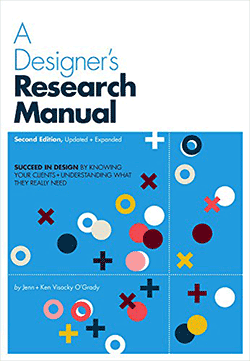“For some reason I have a visual intuition that allows me to design things in an interesting way, and I don’t know where that came from.”—David Carson
Here’s a quotation that is sure to be a favorite for this audience:
“If you have no intuitive sense of design, then call yourself an information architect and only use Helvetica.” —David Carson
Of course, these quotations are from just one celebrity graphic designer, but they are emblematic of a belief that design is about intuition and style rather than solving problems through a rational process. We could more appropriately attribute this viewpoint to an artist’s serving his ego rather than a professional designer who solves problems for people. This misunderstanding of what design really is ultimately makes design less accessible to people. It posits that design professionals must have some innate ability that they cannot share with others—that they were born with a better sense of style than other people. However, in reality, we need more people to be conversant in design and more appreciative of its value.
It wasn’t always this way. While expressiveness in visual design has always existed to some extent, there has also been an understanding that design is a process that leads to good outcomes for people. That is, design seeks outcomes for specific audiences beyond an artist’s taste.
Jenn and Ken Visocky O’Grady provide a strong contrast to designers who espouse style over substance. They are faculty members at Cleveland State University and Kent State University, respectively, and both are graduates of the Visual Communication Design school at KSU. (Full disclosure, Ken is a fellow faculty member at Kent State University, and both Ken and Jenn were graduate students when I was an undergrad there.) They are prolific writers and presenters, and Jenn was recently recognized as a Fellow by the Cleveland Chapter of AIGA for her leadership and contributions to the design community. Their first book, A Designer’s Research Manual, returns to the idea that the role of graphic designers is not just to create pretty or visually interesting artifacts but to solve problems using a process that we call design.
A Designer’s Research Manual might provide the antidote to design that pleases designers themselves more than their audience. Over the course two hundred pages, the book provides a foundation for understanding the role of design and how research informs design outcomes. While the authors have written the book from the perspective of graphic design, its message is applicable for anyone who cares about designing solutions for people.
 As a design discipline, User Experience frequently gets lumped together with visual or graphic design—often to the chagrin of UX professionals. Of course, this tendency reinforces and is reinforced by the common belief that design is defined by its deliverables. Further, the plethora of books, periodicals, annuals, and Web sites that worship the unique style and fashion of graphic design rather than process and outcomes encourages the description of design in terms of its deliverables.
As a design discipline, User Experience frequently gets lumped together with visual or graphic design—often to the chagrin of UX professionals. Of course, this tendency reinforces and is reinforced by the common belief that design is defined by its deliverables. Further, the plethora of books, periodicals, annuals, and Web sites that worship the unique style and fashion of graphic design rather than process and outcomes encourages the description of design in terms of its deliverables.